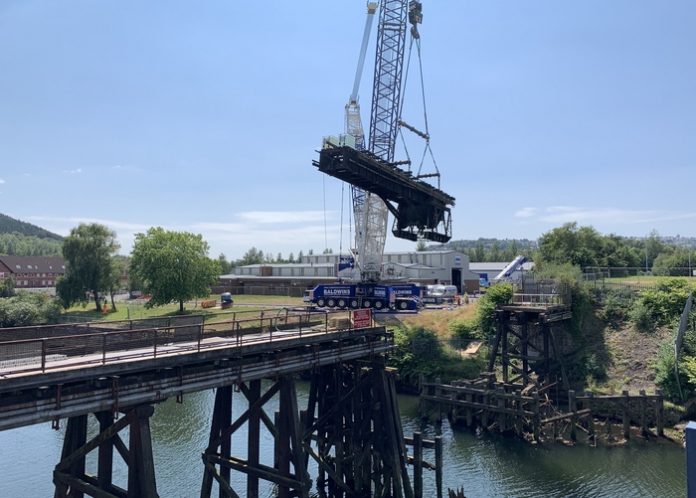A key moment in the preservation of an historic Swansea landmark took place on Sunday, July 14.
The activity saw more than 20 construction professionals, a 53m-tall crane and an articulated low-loader truck remove Landore’s 110-year-old Bascule Bridge for restoration.
The lift was carried out by the Swansea Highways Partnership (SHP) on behalf of Swansea Council.
The bridge – which spans the River Tawe near the Liberty Stadium and weighs around 70 tonnes – is earmarked by the council as a key heritage feature of the immediate area’s bright future.
Detailed preparation work for moving it took place on site for several weeks. The aim is to re-install the restored structure next year following assessment and restoration work at Afon Engineering, Swansea Vale.
Robert Francis-Davies, the council’s cabinet member for investment, regeneration and tourism, said: “We are going to restore and preserve this significant heritage landmark and we successfully carried out the lift on July 14.
“This is big news for the Hafod-Morfa Copperworks area – which is undergoing an exciting regeneration – and for Swansea which is so proud of its industrial past.
“Work is essential at this time to prevent further decay and risk of loss of this Grade Two listed bridge which is also an officially scheduled historic monument. Any further delay would result in the loss of this valuable heritage that forms a critical part of Swansea’s story.
“Our work on the Bascule Bridge will complement the work we are doing to develop a world class tourist destination at the copperworks; this has attracted National Lottery Heritage Funding of £3.75m to restore the Powerhouse for future use as a Penderyn Distillery visitor attraction.”
A unique feature of Swansea’s industrial heritage, the Bascule Bridge was pivotal to the area’s time as the world copper capital. Its hinged steel structure would lift to allow the passage of river traffic.
The steel and timber structure, also known as the Morfa Bridge, was built in 1909 to strengthen Swansea’s world-famous copper industry. It provided a rail link between the Morfa and Upper Bank works
The span between two riverbank stone abutments is around 50m in length and around 3m wide.
A large part of the deck could originally be lifted using a hand-cranked mechanism to allow boats up and down the river.
It was a key river crossing for the copperworks – and the new work will complement other local transformation such as that with Penderyn Whisky.
Due to safety concerns the bridge has been fenced off to the public since 1999. It has hindered river craft travelling upstream.
The restoration work will be carried out in stages including the assessment, repair and reinstatement of the main steel structure then the assessment and repair of the timber elements.
The initial main work on the steel elements is being part funded by Welsh Government Targeted Regeneration and Investment funding support together with a funding contribution form the council.
River users, nearby residents and businesses were kept up to date by council officers involved in July 14’s lift.



















